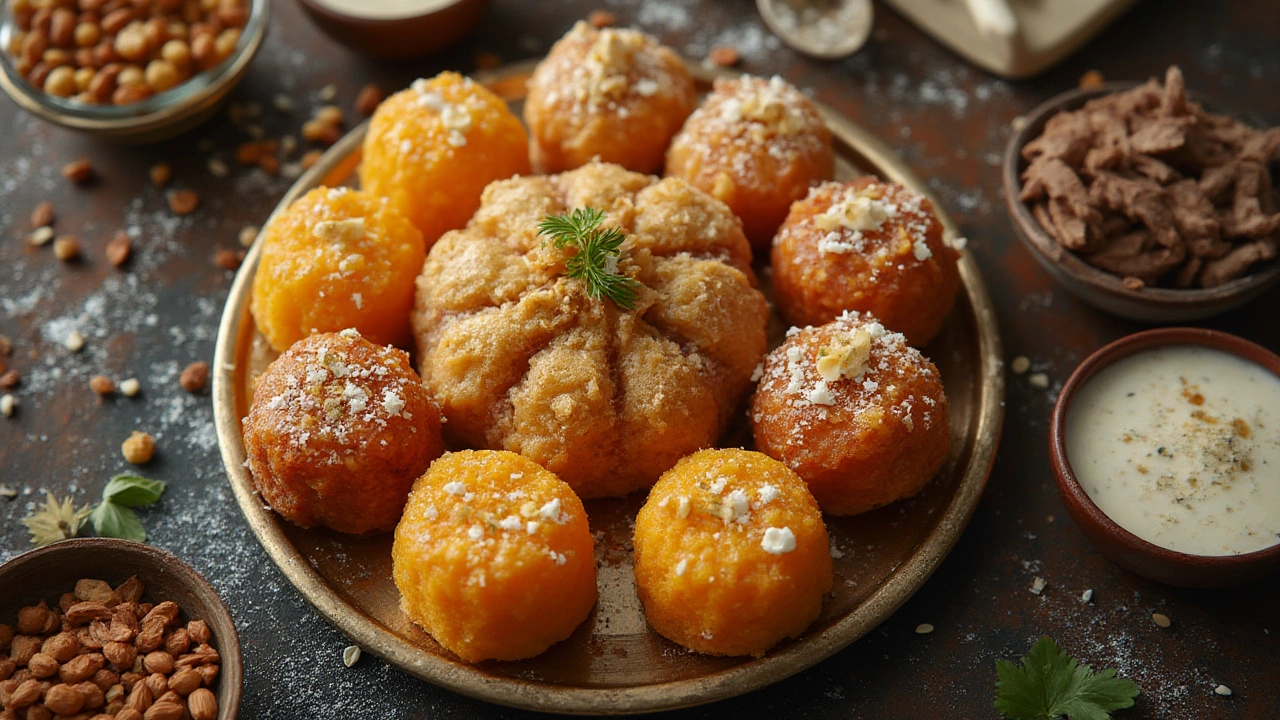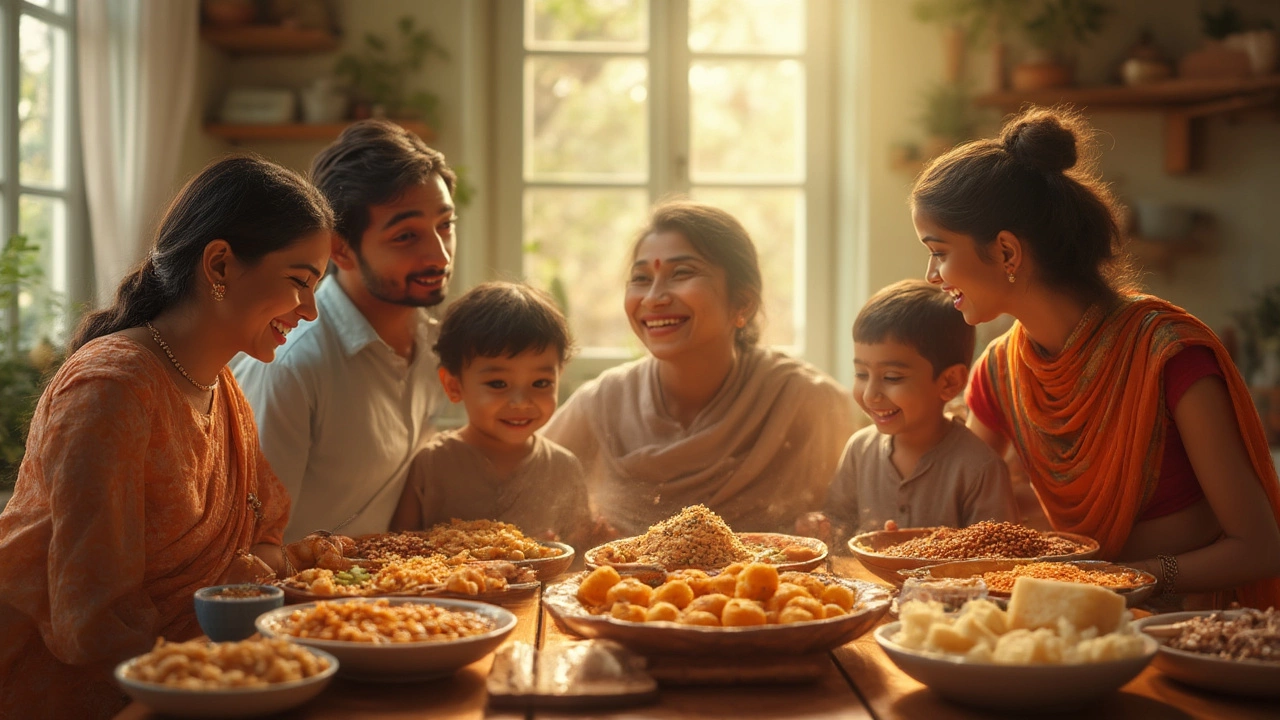Indian sweets are famous for their melt-in-the-mouth goodness, festival nostalgia, and cheerful colors. But here’s a fact that doesn’t get much airtime—some Indian sweets can actually be a sneaky good source of protein. Most people think of protein and turn to chicken or dal, forgetting about the dessert table entirely. But take a closer look, and you’ll spot a few gems that do much more than just spike your blood sugar.
Let’s talk about why this even matters. Protein is the building block for your muscles, helps you feel full longer, and can keep those wild cravings in check. If you’re vegetarian or just trying to up your protein but don’t want to always eat savory foods, knowing which mithai (that’s Hindi for sweets) pull their weight in the protein department is like uncovering a hidden superpower. The big question is: which one is it? Scroll through any Indian sweet shop menu, and you’ll see loads of dairy-based treats and nut-encrusted pieces—there’s actually some serious protein science behind that. Hold on to that curiosity as we deep dive into the tastiest options.
What Makes a Sweet High in Protein?
Protein in desserts sounds weird at first—don’t most sweets just equal sugar, ghee, and carbs? Not necessarily in India. Lots of Indian mithais use high-protein ingredients at their core. If you see the words paneer, khoya, chana, dal, or nuts in the ingredients, your protein radar should beep.
Paneer (Indian cottage cheese) stands out. Sweets made from paneer like Rasgulla, Sandesh, and Cham Cham all get a boost in protein, courtesy of milk. For instance, 100 grams of fresh paneer can dish up around 17-18 grams of protein (that’s the same as three large eggs!). When that gets transformed into a spongy rasgulla or a smooth Sandesh, some protein is lost in the process, but a good chunk stays in your dessert bowl.
Khoya (or mawa), which is reduced evaporated milk, brings similar benefits, though the concentration of protein depends on how much milk was cooked down and what else is added. Some sweets amp up the nutrition by mixing in roasted lentil flour (besan), chickpeas, or split yellow mung dal. Gram flour laddoos (Besan Laddoo) or Moong Dal Halwa sneak in north of 5-7 grams of protein per 100 grams—quite a feat for something you usually have at the end of a meal!
Nuts like almonds, pistachios, and cashews can also tip the protein scales. Badam Katli (almond fudge) and kaju katli (cashew fudge) aren’t just festive showstoppers—they serve up a protein punch thanks to all those ground nuts. Even coconut barfi, when made with added nuts or pulses, can turn into a sneaky protein treat. But beware—nutty sweets can also be calorie dense, so it’s a balancing act.
Let’s break down the protein content of popular Indian sweets for the curious:
| Sweet Name | Main Ingredients | Protein per 100g (approx) |
|---|---|---|
| Rasgulla | Paneer, sugar | 4-6g |
| Sandesh | Paneer, sugar | 5-9g |
| Besan Laddoo | Gram flour, ghee, sugar | 6-8g |
| Moong Dal Halwa | Moong dal, ghee, sugar | 7-9g |
| Badam Katli | Almonds, sugar | 10-12g |
| Kaju Katli | Cashew, sugar | 6-8g |
| Gond ke Laddoo | Nuts, edible gum, flour | 6-10g |
| Malai Peda | Khoya, chhena, sugar | 6-8g |
Notice a pattern? Sweets loaded with paneer, lentils, or nuts consistently lead the pack. If you want the highest protein, look at almond or moong dal-based desserts. Still, different regions, family recipes, and sweet shops might change these numbers, so always glance at the ingredient list or ask how it's made.
Something else to note—Indian sweets aren’t always health food. The high protein contenders might still have tons of sugar and ghee, making them rich as well as nutritious. But if you pick smartly and watch your serving size, you can enjoy dessert with less guilt and more gains.

High-Protein Indian Sweets: The Contenders
If you’re dreaming of a sweet treat that actually does something good for your body, here’s where to start. The protein queens of Indian sweets are usually the ones based on paneer or pulses, so let’s spotlight a few standouts and why they deserve some space on your plate.
- Sandesh: Hailing from Bengal, Sandesh is pure simplicity—just paneer (chhena) and a hint of sugar, sometimes flavored with cardamom or saffron. It’s not loaded with ghee or flour, which means more of that dairy protein makes it into your sweet. You can spot Sandesh at Bengali sweet shops or make it at home—homemade batch, fresh chhena, barely sweetened… that’s protein-forward dessert magic right there.
- Moong Dal Halwa: Warm, nutty, and fragrant. Moong dal (mung beans) are already a protein winner in savory dishes, and when you turn them into a melt-in-the-mouth halwa, you get a rare combo: indulgent comfort plus plant-based protein. One cup (roughly 120g) of Moong Dal Halwa can dish up around 8-10 grams of protein, though the ghee and sugar are generous—so watch your portion.
- Besan Laddoo: Chickpea flour (besan) is another protein hero, with the added bonus of some healthy fiber. The roasted nutty flavor works perfectly with a quick roll in sugar and ghee. Besan laddoo can have about 6-8 grams of protein per 100 grams, thanks to the all-powerful chickpea.
- Badam Katli: Almond fudge is a high-protein, low-effort bliss point for nut-lovers. Almonds are one of the most protein-dense nuts around, punching in at roughly 21g of protein per 100g. Badam katli uses blitzed almond flour, just enough sugar, and minimal fat, so if you want a sweet with maximum muscle, this is your go-to. Try it post-workout for a sweet treat that won’t undo your hard work.
- Paneer Rasgulla: This light, spongy, syrupy favorite is built on, you guessed it, paneer. While the sugar syrup doesn’t do protein any favors, the base is still cheese—that alone gives each juicy ball a small but meaningful protein boost, especially compared to flour-based sweets.
- Gond ke Laddoo: Edible gum (gond), wheat flour, nuts, and seeds all come together in just-right portions to fuel busy mornings in North Indian winters. These laddoos are caloric, yes, but with 7-10 grams of protein per serving (especially if you’re liberal with the nuts and seeds), they’re old-school energy bombs for growing kids or marathoners in your family.
- Khoya Barfi: When milk gets cooked until almost all the water is out, you’re left with a protein- and calcium-rich base called khoya, which is the skeleton of lovely white squares of barfi. Barfi protein content varies depending on if you add nuts or enjoy it plain, but count on at least 5-8 grams per 100 grams of the basic stuff.
Feeling inspired to try your own versions? Here are a few clever tips to amp up the protein count in your sweet:
- Swap part of the sugar in halwa or laddoo with ground roasted seeds—pumpkin, sunflower, or flax seeds are surprisingly high in protein and fiber.
- Experiment with Greek yogurt in creamy desserts. Shrikhand or mishti doi take on extra protein if you strain them and use low-fat yogurt.
- Add roasted or ground nuts to fillings and coatings to double up on texture and nutritional value.
- If you’re making rasgulla or paneer-based sweets at home, use full-fat cow’s milk for the richest, highest-protein chhena. Don’t throw away the leftover whey—add it to smoothies or use it to knead dough.
- Pulses like roasted chana dal can be ground up and mixed into besan laddoo for extra muscle-building benefits.
For the number-obsessed: if you’re counting protein grams, homemade sweets usually win because you can measure each ingredient. Sweets from the mithai shop vary—sometimes there’s more sugar and less dairy or nuts, which waters down the protein payoff. When it comes to protein, as with all nutrition, fresher and simpler usually rules.

Choosing the Healthiest High-Protein Indian Sweet for You
So what should you actually pick when you’re standing in front of a box of mithai, or whipping up dessert at home? If you want the absolute highest protein per bite, make friends with sweets based on almonds or lentils. It sounds counterintuitive—a dessert with beans or nuts? That’s the delicious magic of Indian sweets. Sandesh and besan laddoo are probably your safest bets if you want to avoid super high calorie loads, while Badam Katli is the clear winner in raw protein content (but it’s also high in healthy fats, so be mindful of portion size!).
Got high cholesterol or diabetes? Sweets starring Greek yogurt, fresh paneer, or lightly sweetened khoya might be kinder to your waistline because they can be made with less sugar. Shrikhand, made from strained yogurt and cardamom, is silky, tangy, and far more protein-rich than anything in a bakery’s pastry display. There are even newer, ‘modern’ Indian sweets packed with protein powder or using milk alternatives for vegan eaters. Homemade or ‘healthified’ versions made with stevia, jaggery, chia seeds, or oat flour can boost your protein while still honoring the flavors you love.
Worried that dairy might weigh you down? No panic—nut and lentil sweets hold their own. Moong dal halwa, for example, is naturally gluten-free and welcome to most diets, while besan sweets can be tailored for vegan, dairy-free living if you swap out the ghee for coconut oil or vegetable oil.
To make dessert less of a cheat day experience, here are a few more down-to-earth strategies:
- Stick to sweets made fresh at home so you know exactly what’s inside.
- Pair a finger-sized piece of katli or laddoo with a handful of roasted chickpeas or soy nuts to double the protein power.
- Opt for less syrup—squeeze extra syrup out of rasgulla, or chill and serve halwa in smaller bowls.
- Balance your treat with a cup of unsweetened chai or black coffee to skip the extra calories from sodas or sweetened lassis.
A little planning goes a long way. Indian sweets don’t just satisfy your sweet tooth; the right choices can sneak in some protein while you’re at it. Pick the star of the box—be it badam katli, sandesh, or besan laddoo—and enjoy the rare pleasure of a dessert that pulls double duty. Who knew mithai could work so hard for you?
